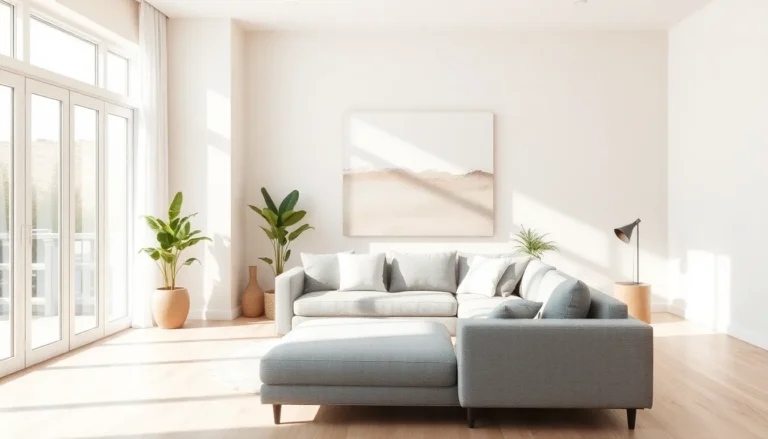Table of Contents
ToggleImagine stepping into a living room where tranquility reigns and every item has a purpose. The minimalist Japanese style isn’t just a design choice; it’s a lifestyle that transforms chaos into calm. With clean lines and a focus on functionality, this aesthetic brings harmony to any space, making it a sanctuary for relaxation and creativity.
Understanding Minimalist Japanese Style
Minimalist Japanese style embodies a calm lifestyle, centering on simplicity and function. This approach results in living spaces that encourage serenity and clarity.
Key Principles of Minimalism
Simplicity defines the essence of minimalism. Clean lines and essential forms create open spaces that invite peace. Functionality plays a crucial role in this style; every piece in the room serves a purpose. Natural light enhances the overall atmosphere, brightening spaces while creating a sense of space. Balance among elements fosters harmony, pairing furniture and decor thoughtfully to avoid clutter.
Characteristics of Japanese Design
Natural materials dominate Japanese design, emphasizing wood, stone, and bamboo. Earthy tones create a calming palette, enhancing the connection to nature. Minimal ornamentation allows for subtlety, with designs focusing on craftsmanship and quality. Sliding doors, tatami mats, and low furniture promote fluidity, enabling an easy transition between indoors and out. Each element embodies a philosophy of ‘wabi-sabi,’ celebrating imperfection and transience in everyday life.
Essential Elements of a Minimalist Japanese Style Living Room
A minimalist Japanese style living room embodies tranquility and harmony. Several essential elements contribute to its serene atmosphere and functional design.
Color Palette
Neutral colors form the foundation of a minimalist Japanese living room. Shades of beige, soft whites, and muted grays create a calm backdrop. Earthy tones introduce warmth and invite a connection to nature. Accents of natural greens and gentle browns often complement this palette. Such color choices maintain simplicity while enhancing spaciousness. This careful selection enhances the overall aesthetic, emphasizing clarity over clutter.
Furniture Selection
Low-profile furniture plays a critical role in this style. Shiki-buton, a traditional Japanese futon, provides a versatile seating option, promoting both comfort and space efficiency. Tatami mats, made from rice straw, add natural texture and warmth to the floor. Minimal tables in light wood or natural materials ensure functionality without overwhelming the space. Each piece prioritizes simplicity and craftsmanship while integrating seamlessly into the overall decor. Flexibility is also important; furniture should encourage fluid movement and enhance the room’s open feel.
Integrating Culture and Functionality
Minimalist Japanese style living rooms combine cultural elements with practical design. This integration emphasizes simplicity while enhancing daily life.
Traditional Influences
Traditional design serves as a foundation for minimalist Japanese interiors. Tatami mats cover the floor, adding texture and warmth. Sliding shoji screens separate spaces, creating a sense of openness. Low furniture promotes ease of movement, allowing for flexibility in arrangement. Natural materials, such as wood and stone, are prominent in traditional aesthetics, grounding the design in nature. Craftsmanship remains paramount, with well-made pieces that highlight functionality.
Modern Adaptations
Modern adaptations build on these traditional elements, merging them with contemporary needs. Clean lines characterize furniture, reflecting a minimalist approach. Bright white walls maximize light, making rooms feel spacious. Modular furniture options provide versatility, catering to various lifestyles. Technology integrates seamlessly into the decor, enhancing convenience without compromising simplicity. This blend maintains the essence of tranquility while accommodating modern living. Overall, modern adaptations respect tradition while promoting practicality.
Tips for Creating Your Own Minimalist Japanese Style Living Room
Creating a minimalist Japanese style living room requires careful planning and attention to detail. Focus on simplicity and functionality to curate a serene environment.
Space Optimization
Space optimization plays a crucial role in achieving a minimalist Japanese style. Prioritizing open floor plans creates a sense of spaciousness. Utilize low furniture, such as shiki-buton futons, to encourage fluid movement. Incorporate tatami mats for a natural look and additional comfort. Ensuring furniture placement fosters flow enhances comfort and accessibility. Limit clutter by selecting multi-functional items, like a low coffee table with storage. Every piece should serve a purpose while maintaining visual harmony.
Decorative Accents
Decorative accents should complement the minimalist Japanese aesthetic. Choose natural materials, such as wood and stone, for tables and shelves. Select a few high-quality art pieces, emphasizing craftsmanship rather than quantity. Incorporate indoor plants like bonsai or bamboo to provide a living element that connects to nature. Soft textiles in neutral shades can be used for cushions and throws to add warmth. Subtle lighting enhances the atmosphere without overwhelming the space. Each accent contributes to a peaceful ambiance, reinforcing the overall tranquility of the room.
Embracing a minimalist Japanese style living room can transform any space into a serene retreat. This design philosophy prioritizes simplicity and functionality while celebrating natural materials and craftsmanship. By focusing on a neutral palette and low-profile furniture, one can create an atmosphere that fosters relaxation and clarity.
Integrating traditional elements like tatami mats and shoji screens with modern touches enhances versatility while maintaining tranquility. The result is a harmonious environment that encourages fluid movement and connection with nature. Adopting these principles not only elevates the aesthetic appeal but also promotes a mindful lifestyle centered on peace and purpose.







